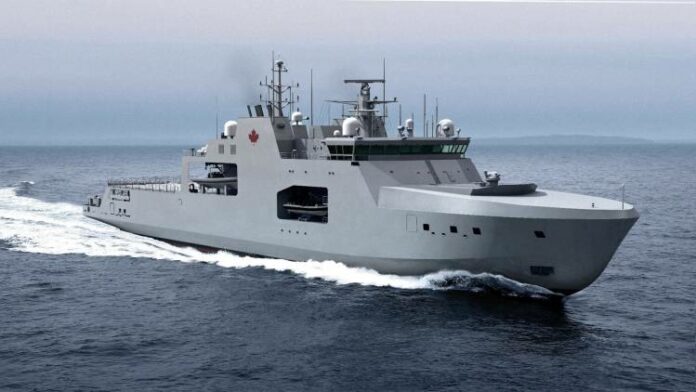The future HMCS Harry DeWolf, the first of Canada's new Arctic and Offshore Patrol Vessels to be built, was launched in Halifax Harbour on Saturday.
At 103 meters (338 feet) and 6,615 tons, the HMCS Harry DeWolf is the largest Royal Canadian Navy ship built in Canada in 50 years. The lead ship in the program is now pier side at Halifax Shipyard where Irving Shipbuilding will continue working to prepare the ship for sea trials in 2019. HMCS Harry DeWolf is scheduled to be turned over to the Royal Canadian Navy in summer 2019.
Construction of the second and third ships, the future HMCS Margaret Brooke and Max Bernays, is underway at Halifax Shipyard. Later this month, the first two major sections of the HMCS Margaret Brooke will be moved outside.
In total, there will be six ice-capable ships, designated as the Harry DeWolf Class, after Canadian wartime naval hero Vice-Admiral Harry DeWolf (biography below).
The new vessels, with a complement of 65, will be capable of armed sea-borne surveillance, including in Canada’s Arctic; providing government situational awareness of activities and events in the region.
Canada's National Shipbuilding Strategy was established to replace the current surface fleets of the Royal Canadian Navy and the Canadian Coast Guard. Irving Shipbuilding was selected to construct the Royal Canadian Navy’s future combatant fleet—Arctic and Offshore Patrol Vessels followed by Canadian Surface Combatants.
Harry DeWolf Class Vessel Features:
• Modern integrated bridge, from which control of navigation, machinery, and damage control systems can be performed.
• Multi-Purpose Operational Space where operational planning and mission execution will be coordinated.
• BAE Mk 38 Gun: Remote controlled 25 mm gun to support domestic constabulary role.
• Enclosed Focsle/Cable Deck protects foredeck machinery and workspace from harsh Arctic environment.
• Helicopter Capability: Depending on the mission, the embarked helicopter could range from a small utility aircraft right up to the new CH-148 maritime helicopter.
• Cargo/Payloads: Multiple payload options such as shipping containers, underwater survey equipment, or a landing craft. Ship has a 20-ton crane to self-load/unload.
• Vehicle Bay: For rapid mobility over land or ice, the ship can carry vehicles such as pickup trucks, ATVs, and snowmobiles.
• Diesel/Electric Propulsion: Propulsion: two 4.5 propulsion MW (induction) motors, and four 3.6 MVA generators.
• Retractable Active Fin Stabilizers deployed to reduce ship roll for open ocean operations, retracted for operations in ice.
• Multi-Role Rescue Boats: Top speed of 35+ knots, 8.5 meters (28 feet) long. Will support rescues, personnel transfers, or boarding operations.
• Bow Thrusters to enable maneuvering or berthing without tug assistance.
Source:maritime-executive


